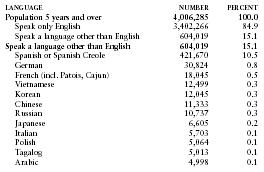Colorado
Languages
The first whites to visit Colorado found Arapaho, Kiowa, Comanche, and Cheyenne Indians roaming the plains and often fighting the Ute in the mountains. Despite this diverse heritage, Indian place-names are not numerous: Pagosa Springs, Uncompahgre, Kiowa, and Arapahoe.
Colorado English is a mixture of the Northern and Midland dialects, in proportions varying according to settlement patterns. Homesteading New Englanders in the northeast spread sick to the stomach, pail, and comforter (tied and filled bedcover), which in the northwest and the southern half are Midland sick at the stomach, bucket, and comfort . South Midland butter beans and snap beans appear in the eastern agricultural strip. Denver has slat fence, and Heinz dog (mongrel). In the southern half of the state, the large Spanish population has bred many loanwords such as arroyo (small canyon or gulley) and penco (pet lamb).
In 2000, 3,402,266 Coloradans—84.9% of the residents five years old and older—spoke only English at home, down from 89.5% in 1990. The following table gives selected statistics from the 2000 census for language spoken at home by persons five years old and over.

| LANGUAGE | NUMBER | PERCENT |
| Population 5 years and over | 4,006,285 | 100.0 |
| Speak only English | 3,402,266 | 84.9 |
| Speak a language other than English | 604,019 | 15.1 |
| Speak a language other than English | 604,019 | 15.1 |
| Spanish or Spanish Creole | 421,670 | 10.5 |
| German | 30,824 | 0.8 |
| French (incl. Patois, Cajun) | 18,045 | 0.5 |
| Vietnamese | 12,499 | 0.3 |
| Korean | 12,045 | 0.3 |
| Chinese | 11,333 | 0.3 |
| Russian | 10,737 | 0.3 |
| Japanese | 6,605 | 0.2 |
| Italian | 5,703 | 0.1 |
| Polish | 5,064 | 0.1 |
| Tagalog | 5,013 | 0.1 |
| Arabic | 4,998 | 0.1 |